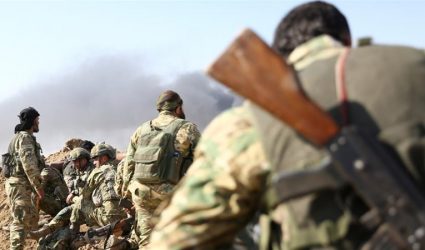Hundreds of ISIL prisoners escape Syrian camp

(Aljazeera) – Hundreds of suspected ISIL detainees have escaped from a camp in northeastern Syria, according to local authorities, as Turkey stepped up its military offensive in the Kurdish-controlled region.
The suspected affiliates of the Islamic State of Iraq and the Levant (ISIL or ISIS) fled the detention facility in Ain Issa on Sunday after attacking guards and storming its gates, the Kurdish-led administration in northern Syria said in a statement.
Jelal Ayaf, a senior official at the camp, told local media that 859 people successfully escaped from the section of the facility housing foreign nationals.
Ayaf added that a few were recaptured, but also warned that “sleeper cells” had emerged from inside another part of the facility and carried out attacks. He described the situation as “very volatile”.
Al Jazeera could not independently verify the numbers.
Turkish President Recep Tayyip Erdogan dismissed the claims of a prison break as “disinformation” aimed at provoking the United States and other western countries, according to Turkey’s state-run Anadolu news agency.
Turkey launched its military operation, now in its fifth day, to clear the border region of the Kurdish-led Syrian Democratic Forces (SDF) and create a “safe zone” to resettle some of the 3.6 million Syrian refugees it hosts on its soil.
‘Catastrophic’ humanitarian crisis
The SDF has repeatedly warned it may not be able to guard the makeshift prisons holding the suspected ISIL fighters as it battles to repel Turkey’s military advance. Ankara considers the People’s Protection Group (YPG), which forms the backbone of the SDF, as “terrorist group” linked to Kurdish separatists inside Turkey.
The SDF was Washington’s main ally in the fight against ISIL, and swept up some 12,000 fighters and 70,000 of their family members in the US-led campaign against the armed group. At its peak, ISIL controlled vast swathes of territory in Syria and neighbouring Iraq under its self-proclaimed “caliphate”.
The US, meanwhile, said it was preparing to evacuate about 1,000 of its troops from northern Syria.
Announcing the withdrawal, Defense Secretary Mark Esper said the situation had become “untenable” for US forces stationed in the area and warned it “gets worse by the hour”.
“We have American forces likely caught between two opposing advancing armies,” he told US broadcaster CBS in a pre-taped interview which aired on Sunday.
Esper said that Washington had learned “in the last 24 hours” that Turkey “likely intend to expand their attack further south than originally planned and to the west”.
The “safe-zone” Turkey had proposed was to span a stretch of territory 120 km wide and 30km deep inside Syria.
Esper said the SDF was also looking to “cut a deal” with Syrian President Bashar al-Assad’s government and Russia, one of its main military backers, to “counterattack against the Turks”.
He added that he was unable to provide a timeline for the withdrawal due to the rapidly changing situation on the ground, but two US defence officials told the Reuters news agency on Sunday that a small number of US troops had already left an outpost in Ain Issa.
Washington’s planned withdrawal from northern Syria comes after US President Donald Trump last weekend abruptly shifted his country’s policy and withdrew some US troops deployed to support SDF fighters in the battle against ISIL.
Trump’s decision in turn effectively helped open the door for Turkey to launch its ongoing offensive.
The operation has attracted rising international disapproval in recent days, with alarm bells raised around the world over concerns the operation could risk reviving ISIL and endanger civilians already beleaguered by Syria’s eight-year civil war.
More than 130,000 people have been displaced from the key Syrian border towns of Tel Abyad and Ras al-Ain and surrounding areas as a result of the fighting, the United Nations said on Sunday, while scores of civilians have been killed.
Sara Kayyali, a Syria researcher for global advocacy group Human Rights Watch (HRW), described the unfolding humanitarian crisis as “catastrophic”.
“These people essentially have nowhere to go,” Kayyali told Al Jazeera from the Jordanian capital, Amman.
“[And] when you take this in the larger context of Syria, where the country is already under strain from a different displacement crisis in the northwest, this means that humanitarians’ ability to respond to the crisis is severely constrained.”
‘New map’ emerging
But Erdogan has shrugged off the criticism, saying Turkey “will not stop” the offensive “no matter what anyone says”.
At a news conference in Istanbul on Sunday, he said Turkish-led forces had killed 440 SDF fighters since the start of the push, and had so far captured 109 square kilometres (42 square miles) of terrain including 17 villages around Tel Abyad and four villages around Ras Al Ain. The SDF, meanwhile, put the number of its own forces killed at 45.
Al Jazeera’s Zeina Khodr, reporting from Akcakale on the Turkey-Syria border, said a “new map” was emerging in northeastern Syria given the gains made by Turkish troops and allied Syrian rebel forces.
“They are now in control of a 120 kilometre stretch of territory along the border,” Khodr said.
“There are pockets of resistance here and there … but Turkish-led forces have also pushed some 30-35km deep inside Syria reaching the strategic M4 highway – that critical supply line that all players in this conflict want to control,” she added.
The M4 is the main highway running between Hassakeh and Ain Issa, the administrative centre of the Kurdish-held areas in northeastern Syria.
Trump’s retreat in Syria turns into a mess

